The GeForce GTX 660 Ti Review, Feat. EVGA, Zotac, and Gigabyte
by Ryan Smith on August 16, 2012 9:00 AM ESTPower, Temperature, & Noise
As always, we’re wrapping up our look at a video card’s stock performance with a look at power, temperature, and noise. Like we discussed in the introduction, while the official TDP of the GTX 660 Ti is 150W – 20W lower than the GTX 670 – the power target difference is only 7W. So let’s see which is more accurate, and how that compares to AMD’s cards.
| GeForce GTX 660 Ti Voltages | ||||
| Zotac GTX 660 Ti Boost Load | EVGA GTX 660 Ti Boost Load | Gigabyte GTX 660 Ti Boost Load | ||
| 1.175v | 1.162v | 1.175v | ||
Stopping to take a quick look at voltages, there aren’t any big surprises here. NVIDIA would need to maintain the same voltages as the GTX 670 because of the identical clocks and SMX count, and that’s exactly what has happened. In fact all single-GPU GK104 cards are topping out at 1.175v, NVIDIA’s defined limit for these cards. Even custom cards like the Gigabyte still only get to push 1.175v.
Up next, before we jump into our graphs let’s take a look at the average core clockspeed during our benchmarks. Because of GPU boost the boost clock alone doesn’t give us the whole picture – particularly when also taking a look at factory overclocked cards – we’ve recorded the clockspeed of our video cards during each of our benchmarks when running them at 2560x1600 and computed the average clockspeed over the duration of the benchmark. Unfortunately we then deleted the results for the factory overclocked cards, so we only have the “reference” card. Sorry about that guys.
| GeForce GTX 600 Series Average Clockspeeds | |||||||
| GTX 670 | GTX 660 Ti | Zotac GTX 660 Ti | EVGA GTX 660 Ti | Gigabyte GTX 660 Ti | |||
| Max Boost Clock | 1084MHz | 1058MHz | 1175MHz | 1150MHz | 1228MHz | ||
| Crysis | 1057MHz | 1058MHz | N/A | ||||
| Metro | 1042MHz | 1048MHz | |||||
| DiRT 3 | 1037MHz | 1058MHz | |||||
| Shogun 2 | 1064MHz | 1035MHz | |||||
| Batman | 1042MHz | 1051MHz | |||||
| Portal 2 | 988MHz | 1041MHz | |||||
| Battlefield 3 | 1055MHz | 1054MHz | |||||
| Skyrim | 1084MHz | 1045MHz | |||||
| Civilization V | 1038MHz | 1045MHz | |||||
The average clockspeeds on our “reference” GTX 660 Ti don’t end up fluctuating all that much. With a max boost of 1058 the card actually gets to run at its top bin in a few of our tests, and it isn’t too far off in the rest. The lowest is 1035 for Shogun 2, and that’s only an average difference of 22MHz. The GTX 670 on the other hand had a wider range; a boon in some games and a bane in others. If nothing else, it means that despite the identical base and boost clocks, our cards aren’t purely identical at all times thanks to the impact of GPU boost pulling back whenever we reach our power target.
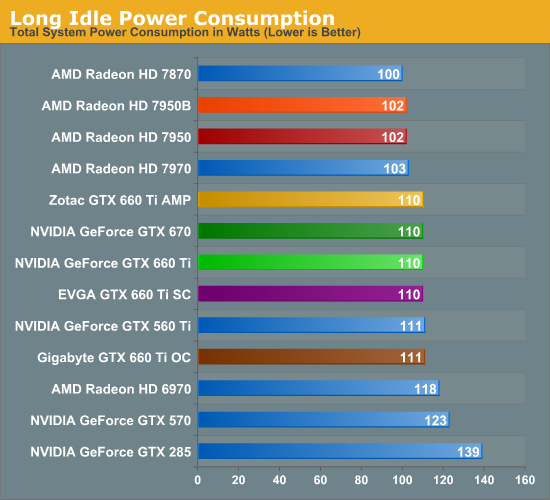
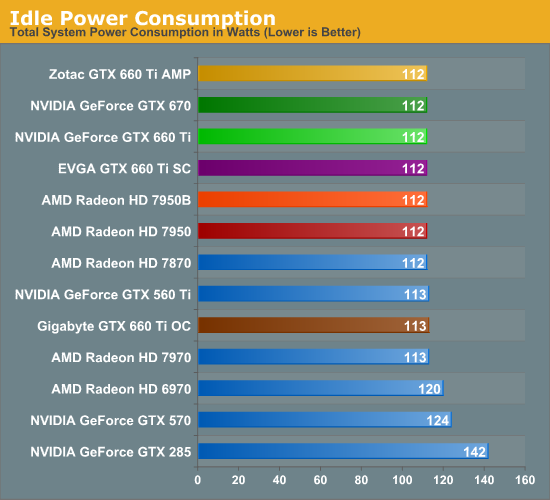
There are no great surprises with idle power consumption. Given the immense similarity between the GTX 670 and GTX 660 Ti, they end up drawing the same amount of power both during idle and long idle. This does leave AMD with an 8W-10W lead at the wall in this test though.
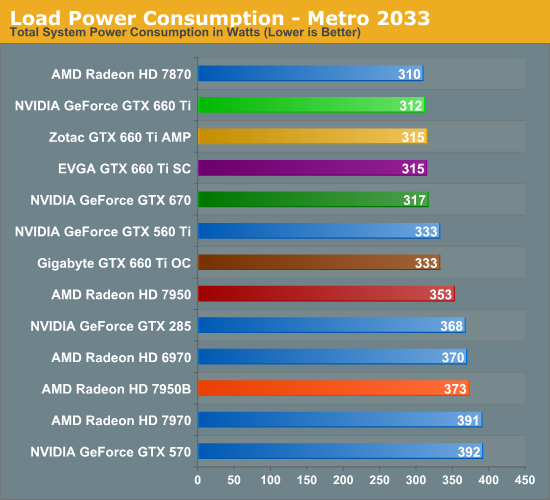
Moving on to our load power tests we start with Metro: 2033. As we mentioned previously the GTX 660 Ti and GTX 670 have very similar power targets, and this benchmark confirms that. Power consumption for the GTX 660 Ti is virtually identical to the Radeon HD 7870, an interesting matchup given the fact that this is the first time NVIDIA has had to compete with Pitcairn. Pitcairn’s weaker compute performance means it starts off in a better position, but it looks like even with a salvaged GK104 NVIDIA can still compete with it. NVIDIA drove efficiency hard this generation; to compete with a smaller chip like that is certainly a testament to that efficiency.
As for the inevitable 7950 comparison, it’s no contest. The GTX 670 was already doing well here and the GTX 660 Ti doesn’t change that. Tahiti just can’t match GK104’s gaming efficiency, which is why AMD has had to push performance over power with the new 7950B.
Meanwhile it’s fascinating to see that the GTX 660 Ti has lower power consumption than the GTX 560 Ti, even though the latter has the advantage of lower CPU power consumption due to its much lower performance in Metro. Or better yet, just compare the GTX 660 Ti to the outgoing GTX 570.
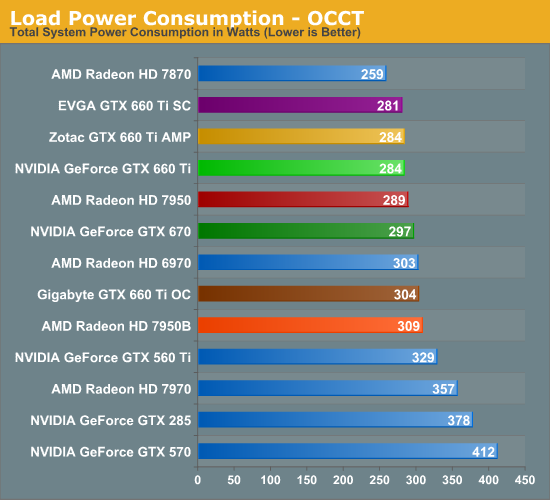
For AMD/NVIDIA comparisons we have a bit less faith in our OCCT results than we do our Metro results right now, as NVIDIA and AMD seem to clamp their power consumption differently. NVIDIA’s power consumption clamp through GPU Boost is far softer than AMD’s PowerTune. As a result the 7870 consumes 25W less than the GTX 660 Ti here, which even with AMD’s very conservative PowerTune rating seems like quite the gap. Metro seems to be much more applicable here, at least when you’re dealing with cards that have similar framerates.
In any case, compared to NVIDIA’s lineup this is another good showing for the GTX 660 Ti. Power consumption at the wall is 45W below the GTX 560 Ti, a large difference thanks to the latter’s lack of power throttling technology.
As for our factory overclocked cards, these results are consistent with our expectations. Among the Zotac and EVGA cards there’s a few watts of flutter at best, seeing as how they have the same power target of 134W. Meanwhile the Sapphire card with its higher power target is 20W greater at the wall, which indicates that our estimated power target of 141W for that card is a bit too low. However this also means that those times where the Gigabyte card was winning, it was also drawing around 20W more than its competition, which is a tradeoff in and of itself.
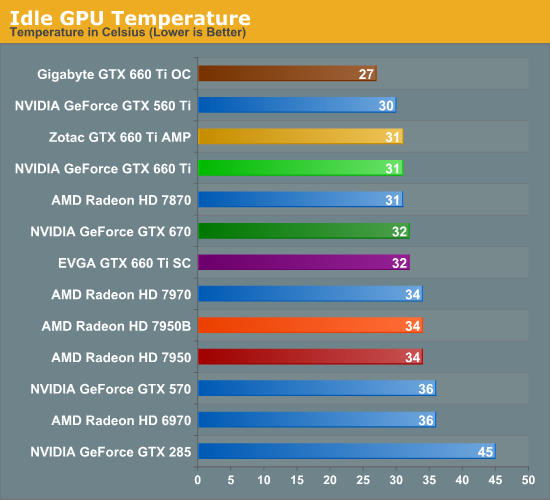
Moving on to temperatures, at 31C the GTX 660 Ti is once more where we’d expect it to be given the similarities to the GTX 670. Open air coolers tend to do a bit better here than blowers though, so the fact that it’s only 1C cooler than the blower-type GTX 670 is likely a reflection on Zotac’s cooler.
Speaking of factory overclocked video cards, one card stands out above the rest: the Gigabyte GTX 660 Ti. That oversized cooler does its job and does it well, keeping the GPU down to barely above room temperature.
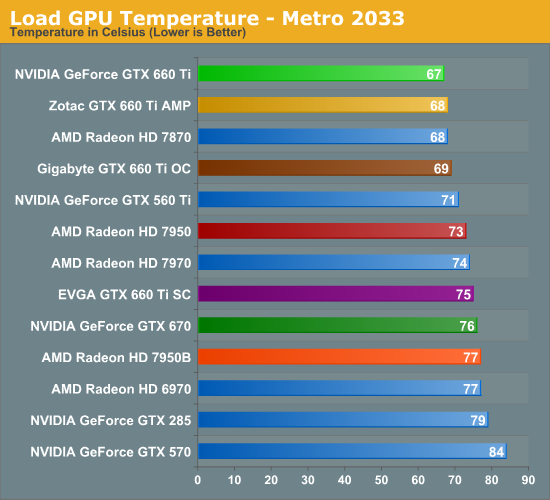
Considering that most of our high-end cards are blowers while our “reference” GTX 660 Ti is an open air cooler, temperature benchmarks are the GTX 660 Ti’s to win, and that’s precisely what’s going on. 67C is nice and cool too, which means that the open air coolers should fare well even in poorly ventilated cases.
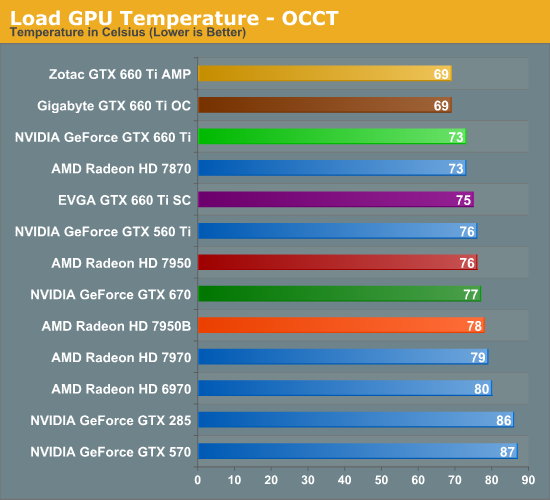
As usual we see a rise in temperatures when switching from Metro to OCCT, but at 73C the GTX 660 Ti is still the coolest reference (or semi-reference) card on the board. To be honest we had expected that it would beat the 7870, but as far as blowers go the 7870’s is quite good.
Moving on to our factory overclocked cards, we’re seeing the usual divisions between open air coolers and blowers. The blower-based EVGA card performs almost identically to the GTX 670, which makes sense given the similarities between the cards. Meanwhile the open air Zotac and Gigabyte cards are neck-and-neck here, indicating that both cards are shooting for roughly the same temperatures, keeping themselves below 70C. Though it’s somewhat weird to see the factory overclocked Zotac card end up being cooler than its reference-clocked self; this appears to be a product of where the fan curve is being hit.
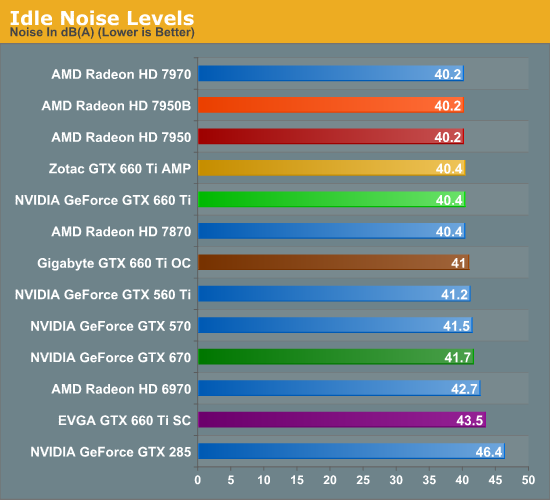
Last but not least we have our look at noise, where we’ll hopefully be able to fully shake out our factory overclocked cards.
Right off the bat we see the blower-based EVGA struggle, which was unexpected. It’s basically the same cooler as the GTX 670, so it should do better. Then again the EVGA GTX 670 SC had the same exact problem.
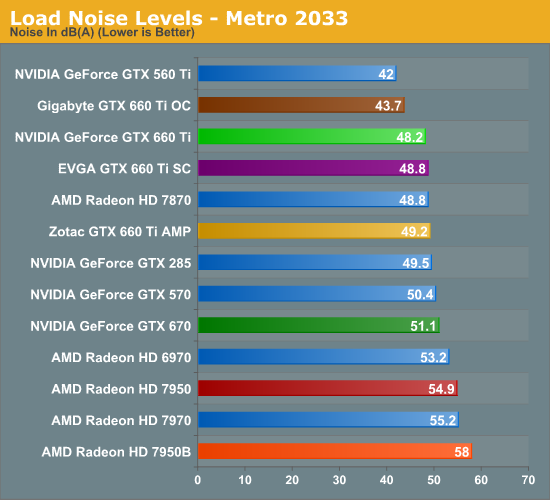
As for Metro, the GTX 660 Ti once again looks good. 48.2 isn’t the best for an open air cooler, but it’s a hair quieter than the 7870 and notably quieter than the GTX 670. The only unfortunate part about these results is that it just can’t beat the GTX 560 Ti; in fact nothing can. For its power consumption the GTX 560 Ti was an almost unreal card, but it’s still a shame the GTX 660 Ti can’t be equally unreal.
Moving on to our factory overclocked cards however, the Gigabyte GTX 660 Ti OC gets very close thanks to its very large cooler. 43.7dB technically isn’t silent, but it just as well should be. To offer the performance of a GTX 660 Ti (and then some) in such a package is quite the accomplishment.
As for Zotac and EVGA, there’s nothing bad about either of them but there’s also nothing great. EVGA’s card is about average for a blower, while Zotac’s card seems to be suffering from its size. It’s a relatively tiny card with a relatively tiny cooler, and this has it working harder to hit its temperature targets.
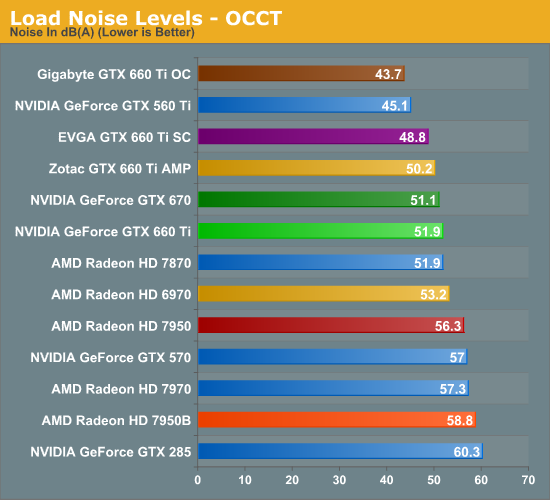
Finally we have noise testing with OCCT. Our “reference” GTX 660 Ti actually fares a bit worse than the GTX 670, which is unfortunate. So much of this test comes down to the cooler though that it’s almost impossible to predict how other cards will perform. At least it’s no worse than the 7870.
Meanwhile the Gigabyte GTX 660 Ti OC continues to impress. 43.7dB not only means that it didn’t get any louder switching from Metro to OCCT, but it has now bested the GTX 560 Ti thanks to the 560’s lack of power throttling technology. Make no mistake, 43.7dB for this kind of performance is very, very impressive.
As for EVGA and Zotac, it’s also a rehash of Metro. EVGA’s blower is actually over 1dB quieter than Zotac’s cooler, which is an unfortunate outcome for an open air cooler.
Wrapping things up, even without a true reference sample from NVIDIA it’s clear that the GTX 660 Ti has a lot of potential when it comes to power/temp/noise. Compared to other cards it’s roughly equivalent in power consumption and noise to the 7870, which for NVIDIA is an important distinction since it’s also notably faster than the 7870, so NVIDIA is on a better place on the power/performance curve. This goes for not only the 7870, but especially the 7950, where the GTX 660 Ti continues the tradition the GTX 670 already set, which will see the GTX 660 Ti being cooler, quieter, and less power hungry than AMD’s entry-level Tahiti part.
But it must be pointed out that the lack of a reference design for the GTX 660 Ti means buyers are also facing a lot of variability. Power consumption should be consistent between cards – which is to say a hair less than the GTX 670 – but temperature and especially noise will vary on a card by card basis. Potential buyers would best be served by checking out reviews ahead of time to separate the duds from the gems.










313 Comments
View All Comments
Oxford Guy - Thursday, August 16, 2012 - link
What is with the 285 being included? It's not even a DX 11 card.Where is the 480? Why is the 570 included instead of the 580?
Where is the 680?
Ryan Smith - Saturday, August 18, 2012 - link
The 285 was included because I wanted to quickly throw in a GTX 285 card where applicable, since NVIDIA is promoting the GTX 660 Ti as a GTX 200 series upgrade. Basically there was no harm in including it where we could.As for the 480, it's equivalent to the 570 in performance (eerily so), so there's never a need to break it out separately.
And the 680 is in Bench. It didn't make much sense to include a card $200 more expensive which would just compress the results among the $300 cards.
CeriseCogburn - Sunday, August 19, 2012 - link
So you're saying the 680 is way faster than the 7970 which you included in every chart, since the 7970 won't compress those $300 card results.Thanks for admitting that the 7970 is so much slower.
Pixelpusher6 - Friday, August 17, 2012 - link
Thanks Ryan. Great review as always.I know one of the differentiating factors for the Radeon 7950s is the 3GB of ram but I was curious are there any current games which will max out 2GB of RAM with high resolution, AA, etc.?
I think it's interesting how similar AMDs and Nvidias GPUs are this generation. I believe Nvidia will be releasing the GTX 660 non Ti based on GK106. Leaked specs seem to be similar to this card but the texture units will be reduced to 64. I wonder how much of a performance reduction this will account for. I think it will be hard for Nvidia to get the same type of performance / $ as say GTX 460 / 560 Ti this generation because of having to have GK104 fill in more market segments.
Also I wasn't aware that Nvidia was still having trouble meeting demand with GK104 chips I thought those issues were all cleared up. I think when AMD released their 7000 series chips they should have taken advantage of being first to market and been more competitive on price to grow market share rather than increase margins. At that time someone sitting on 8800GT era hardware would be hard pressed to upgrade knowing that AMDs inflated prices would come down once Nvidia brought their GPUs to market. People who hold on to their cards for a number of years is unlikely to upgrade 6 months later to Nvidias product. If AMD cards were priced lower at this time a lot more people would have bought them, thereby beating Nvidia before they even have a card to market. I do give some credit to AMD for preparing for this launch and adjusting prices, but in my opinion this should have been done much earlier. AMD management needs to be more aggressive and catch Nvidia off guard, rather than just reacting to whatever they do. I would "preemptively" strike at the GTX 660 non Ti by lowering prices on the 7850 to $199. Instead it seems they'll follow the trend and keep it at $240-250 right up until the launch of the GTX 660 then lower it to $199.
Ryan Smith - Saturday, August 18, 2012 - link
Pixelpusher, there are no games we test that max out 2GB of VRAM out of the box. 3GB may one day prove to be advantageous, but right even at multi-monitor resolutions 2GB is doing the job (since we're seeing these cards run out of compute/render performance before they run out of RAM).Sudarshan_SMD - Friday, August 17, 2012 - link
Where are naked images of the card?CeriseCogburn - Thursday, August 23, 2012 - link
You don't undress somebody you don't love.dalearyous - Friday, August 17, 2012 - link
it seems the biggest disappointment i see in comments is the price point.but if this card comes bundled with borderlands 2, and you were already planning on buying borderlands 2 then this puts the card at $240, worth it IMO.
rarson - Friday, August 17, 2012 - link
but it's the middle of freaking August. While Tahiti was unfortunately clocked a bit lower than it probably should have been, and AMD took a bit too long to bring out the GE edition cards, Nvidia is now practically 8 months behind AMD, having only just released a $300 card. (In the 8 months that have gone by since the release of the 7950, its price has dropped from $450 to $320, effectively making it a competitor to the 660 Ti. AMD is able to compete on price with a better-performing card by virtue of the fact that it simply took Nvidia too damn long to get their product to market.) By the time the bottom end appears, AMD will be ready for Canary Islands.It's bad enough that Kepler (and Fermi, for that matter) was so late and so not available for several months, but it's taking forever to simply roll out the lower-tier products (and yes, I know 28nm wafers have been in short supply, but that's partially due to Nvidia's crappy Kepler yields... AMD have not had such supply problems). Can you imagine what would have happened if Nvidia actually tried to release GK110 as a consumer card? We'd have NOTHING. Hot, unmanufacturable nothing.
Nvidia needs to get their shit together. At the rate they're going, they'll have to skip an entire generation just to get back on track. I liked the 680 because it was a good performer, but that doesn't do consumers any good when it's 4 months late to the party and almost completely unavailable. Perhaps by the end of the year, 28nm will have matured enough and Nvidia will be able to design something that yields decently while still offering the competitiveness that the 680 brought us, because what I'd really like to see is both companies releasing good cards at the same time. Thanks to Fermi and Kepler, that hasn't happened for a while now. Us consumers benefit from healthy competition and Nvidia has been screwing that up for everyone. Get it together, Nvidia!
CeriseCogburn - Sunday, August 19, 2012 - link
So as any wacko fanboy does, you fault nVidia for releasing a card later that drives the very top end tier amd cards down from the 579+ shipping I paid to $170 less plus 3 free games.Yeah buddy, it's all nVidia's fault, and they need to get their act together, and if they do in fact get their act together, you can buy the very top amd card for $150, because that's likely all it will be worth.
Good to know it's all nVidia's fault. AMD from $579+plus ship to $409 and 3 free games and nVidia sucks for not having it's act together.
The FDA as well as the EPA should ban the koolaid you're drinking.